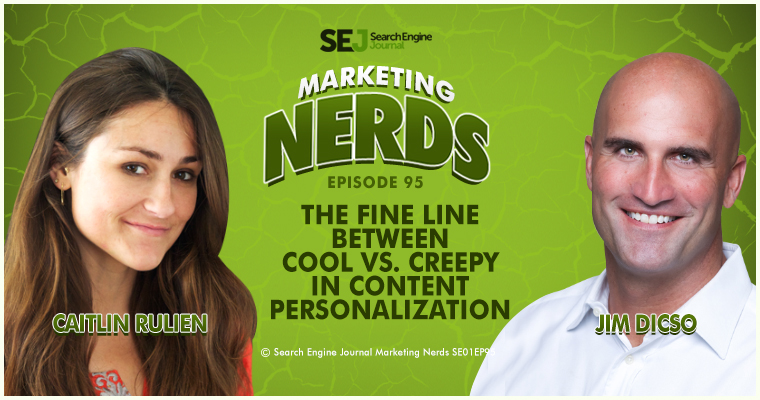Podcast: Download
Subscribe: Apple Podcast Google Podcasts Spotify
Visit our Marketing Nerds archive to listen to other Marketing Nerds podcasts!
In this episode of Marketing Nerds, Caitlin Rulien sits down with Jim Dicso of SundaySky to talk about content personalization, and what makes it cool versus what makes it creepy. Jim also shared how to do content personalization right, which platforms to use, and what tactics brands should avoid.

Here are a few transcribed excerpts from their discussion, but make sure to listen to the podcast to hear everything:
Why More Brands are Focusing on Content Personalization
One of the things we’ve identified in our conversations with most large brands is that they’ve come to realize customer intimacy is becoming ever more the strategic, competitive means of how they want to differentiate their business.
Being able to understand more about individual wants, needs, and behaviors of the prospects and customers that they’re looking to work with requires them to be able to deliver a more personalized experience as a means of acquiring them in the first place, and then also retaining and growing that relationship over time.
When is Personalized Being Too Personalized?
There are certain points in the customer life-cycle where customers absolutely expect de-personalization and then other areas where it’s completely inappropriate to enable de-personalization.
I’ll just share some concepts with you, so when I authenticated to my banks portal, or my airline portal, I’ve got a transactional history and scheduled activities, and I expect them to have the entire experience personalized to me because it’s my data and that’s the reason that I have a username and password. If I come back to that same website and I don’t authenticate, the fact that they may know me, having been there before and they put “Welcome back, James!”, seeing they know who I am when I return, again I would expect and feel good about that.
However, if I’m on CNN watching a news article, or news story, reading a news story, or watching a news video, if they were to speak to me by name in that public internet, that would be creepy because they don’t have the rights to do that, and they don’t have my permission to do that. I think that’s where you start to get to that creepiness factor. In those environments, personal relevance is good; personalization is bad.
Example of Personalization Done Right
One of our customers is Atlantis Resorts in the Bahamas, and they’re one that I would highlight as a very effective user of personalized information.
If you book a trip to the Atlantis Resort you will spend a fair amount of money, you’ll give them information about who’s going, so is it a family, or is it just adults. You may share some of the things you’d want to do while you are there, and they have a stream of communications, post-booking, pre-arrival, that are designed to help you get more out of your experience on the property.
There’s so much to do that you want to make sure that people realize all of the opportunities available to them before they get there, and then while they’re there.
Additionally, they capture information about why you’re going, and in some cases what you did, and they use that as part of a follow-up strategy.
Let’s say it’s for an event, whether it’s a birthday, or you have your wedding there, or you go there for your honeymoon, they know that’s why you came and then they have outbound communications in the subsequent years, so an anniversary or birthday communication that says, “You had a wonderful time here four years ago for your honeymoon. We’d love to welcome you back for your anniversary. Here’s a special promotion for return visitors.”
It brings back, hopefully, a positive experience that I had while I was there for my honeymoon, and the fact that they’re offering me a special promotion to come back and visit on my anniversary. That’s a great touch, and it drives real value.
The Right Way to Capitalize on Personalization
My number one tip would be to change the thinking from next best offer, which is a traditional marketing tactic where they want to propose an offer to a customer based on what they know about them, to next best action. Sometimes that action is an offer, but often that action is a proposed approach for how to get more value, for money that you’re already spending.
A simple example is a cable provider that has sold a customer a TV package–let’s say TV and internet package–and that package includes DVR and video on demand for the TV, and mobile Wi-Fi for the internet and they know whether or not I’ve ever watched a DVR movie or a video on demand movie, or if I’ve used their Wi-Fi hotspots. If I haven’t, then that’s likely that I’m a less sticky customer than if I did take full advantage of the package that was available to me.
If you are communicating with a customer, and you know that customer has a value-added service in a package they’ve never used, then the next best action would be to take advantage of that package and reduce the likelihood that the customer will not see value for money.
If, over time, you recommend things to them that don’t cost them money, but allow them to get more value from the money they’re already spending, then when you’re making the next best offer, that offer is going to be received in a much more friendly manner because they see you as a value-added provider, as opposed to a company that’s only ever engaging you with sales messages.
What is the Best Platform to Do Content Personalization?
It comes down to contextual relevance–at least for our view and our experience and what we’re seeing in the market.
If you’re pushing messages to the customer, then you’ve chosen to engage them at a time of your choice. It’s not time relevant to the individual. However, if I’ve taken the time to go to a website, or to open up a company’s app and login to that app, then I’ve chosen to engage you, and that’s the best time for you to re-engage me with a more personalized message.
So, we absolutely believe that it is most relevant when the person has chosen to come to you.
What Brands Should Avoid
If the consumer is in the public domain, and the brand communicates to them with personal data, first name being one of them, but other personal data, that’s clearly over the line. It’s not only creepy, but you also violated their trust, which is very, very difficult to get back.
Last Minute Tips on Content Personalization
Content personalization should take advantage not just of what you know about the profile of the person, so that I’m a married father of two who has reached his mid-40s, which is my personal profile, but to know more about my past behavior.
If I’m the customer of a cable company, as I shared earlier, and I have certain ways that I use my cable package, having the cable provider know that and be able to personalize content and recommendations to me that would allow me to get more value from what I already have, I think, is critical.
The key question for a lot of service-based companies is: How do you unlock the transactional utilization?
To listen to this Marketing Nerds Podcast with Caitlin Rulien & Jim Dicso:
- Listen to the full episode at the top of this post
- Subscribe via iTunes
- Sign up on IFTTT to receive an email whenever the Marketing Nerds podcast RSS feed has a new episode
- Listen on Stitcher
Think you have what it takes to be a Marketing Nerd? If so, message Kelsey Jones on Twitter, or email her at kelsey [at] searchenginejournal.com.
Visit our Marketing Nerds archive to listen to other Marketing Nerds podcasts!
Image Credits
Featured Image: Image by Paulo Bobita
In-post Photo: mayrum2/DepositPhotos.com





